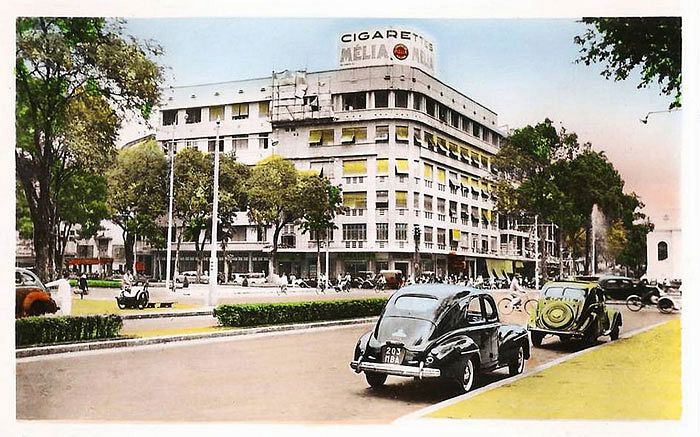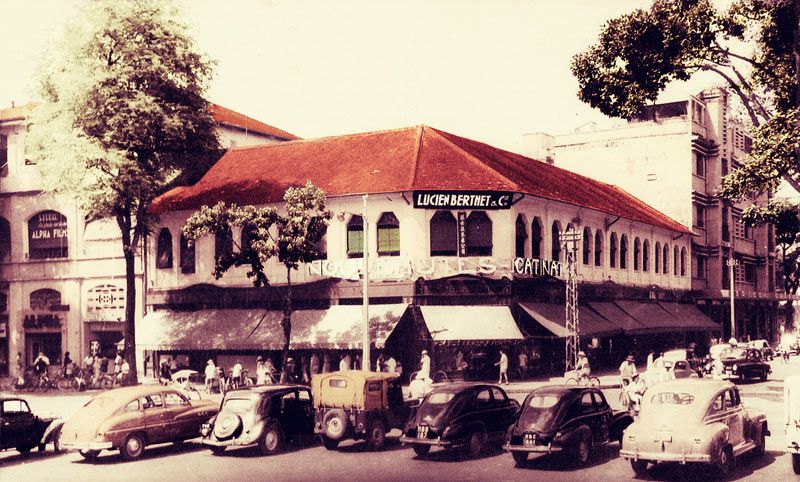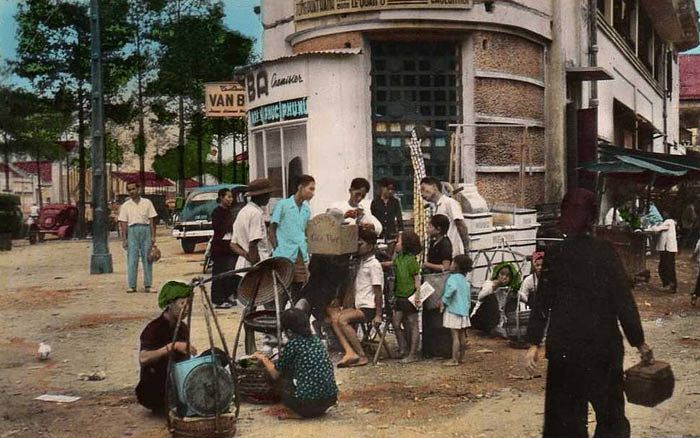The Hùng King Temple at 2 Nguyễn Bỉnh Khiêm was originally built in 1927-1929 under the name Temple du Souvenir Annamite (“Annamite Temple of remembrance”), primarily to honour the memory of Vietnamese soldiers who died while fighting in World War I.
Related Articles:
- Old Saigon Building Of The Week: 136 Lý Tự Trọng
- Old Saigon Building Of The Week: The Grand Hotel
- Old Saigon Building Of The Week: 128 Nguyễn Thị Minh Khai
It is a little-known fact that more than 92,000 Vietnamese men from French Indochina fought in the French armed forces during the Great War of 1914-1918, and it’s been estimated that at least 12,000 of these lost their lives during that conflict.
In 1920, the Cochinchina authorities decided to build a Great War memorial and cenotaph to honour all those who fought and died for France during World War I. This Monument aux morts de la Grande Guerre was inaugurated on 11 November 1927 on place Maréchal Joffre (now Turtle Lake).

The Monument aux Morts de la Grande Guerre.
However, leaders of the Vietnamese community in Saigon felt that there should also be a dedicated memorial to the large number of local soldiers who lost their lives in the conflict, and that this should take the traditional form of a temple to worship their memory. After extensive discussion, it was decided that this temple should honour not just Vietnamese war dead, but also great historical figures associated with the south.
Consequently in 1921, the Cochinchina administration granted a plot of land next to the Botanical Gardens and a committee was set up under patronage of Cochinchina Governor Le Gallen to raise funds for the construction of the Temple du Souvenir Annamite. The fundraising campaign was targeted at the wealthy Vietnamese community of Saigon – “proprietors, shopkeepers, civil servants and others for whom the work or sacrifice of our dear departed has assured happiness.”

The Temple du souvenir Annamite in the late colonial period.
By 1927, a public subscription of 48,000 piastres had been raised, and in November 1927, when architect Auguste Delaval was commissioned to design the new city museum, he was also charged with designing and supervising the construction of the Temple du Souvenir Annamite on the adjacent site.
Built of masonry around a wooden frame supplied by the École professionnelle de Thu-Dau-Mot, and inaugurated together with the new Musée Blanchard de la Brosse (now the Hồ Chí Minh City History Museum) on 1 January 1929, the Temple was described by Le Progrès Annamite newspaper as “a place where the great figures of history, the mandarin benefactors of the people, the writers of talent and the dead of the Great War will be combined in a single official cult.”
Dragons flanked the stone steps leading up to the temple, which was designed in a style typical of Nguyễn-dynasty mausoleums in Huế, with a three-layered curved roof richly decorated with dragons and phoenixes.

A colonial-era view of the Musée Blanchard de la Brosse from the Temple du souvenir Annamite.
The newspaper described the Temple as “a building of pure Annamite style, its interior decorated with sculptural motifs which bring together dragons and other symbolic animals (cranes, unicorns, turtles and phoenixes)” and featuring “masonry walls which combine durability with the fine elegance of collonades and bas-reliefs made from precious wood.” Each of the 12 black wooden pillars supporting the roof represented a sign of the zodiac.

The Temple du souvenir Annamite has always been popular with photographers.
In the centre of the temple was placed “a marble stele, where, next to the famous names of Le-Van-Duyet, Phan-Thanh-Giang, Nguyen-Huynh-Duc, Truong-Vinh-Ky, Tong-Doc-Loc, Tong-Doc-Phuong, Paulus Cua and Le-Quang-Hien, are inscribed the more modest but no less glorious names of our brave Annamites who died on the field of battle.”
The newspaper concluded that “as well as a place of meditation and pilgrimage for the Annamites, the monument will also be a masterpiece where foreign tourists will come to appreciate the beauty of our local art.”
In 1955, the temple was rededicated to the memory of the founding Hùng dynasty of Việt Nam, and officially renamed the Đền Quốc tổ Hùng Vương (National Hùng King Ancestor Temple), although the original stele remained and the temple continued to be known popularly as Đền Kỷ niệm (“Temple of remembrance”).

This 1950s Ford advert used the Temple du souvenir Annamite as a location.
After Reunification, the memorial stele was removed and the temple was dedicated exclusively to the Hùng kings. Today, the main Hùng king shrine stands at the centre of the temple, guarded by a set of eight bronze-tipped weapons (lỗ bộ), a gong and a drum. Various other items are placed around the side of the hall, including two replica Đông Sơn drums and a model of the main Hùng King Temple in the northern province of Phú Thọ.
Each year, on the 10th day of the third lunar month (usually around mid April), the temple hosts the city’s official Hùng King Ancestors Festival, which begins with a solemn ceremony giving thanks to the Hùng dynasty for their contribution to the Vietnamese nation.
In the yard immediately in front of the Hùng Temple is a three-ton bronze elephant statue mounted on a rectangular concrete pedestal. This was presented as a gift to the city by King Rama VII of Siam on the occasion of his first visit to Indochina on 14 April 1930.

A 1960s shot of the bronze elephant statue presented as a gift to the city by King Rama VII of Siam in 1930.

The The Hùng King Temple today. Photo via Wikicommons.
Getting there

Address: Đền thờ vua Hùng, 2 Nguyễn Bỉnh Khiêm, Phường Bến Nghé, Quận 1, Thành Phố Hồ Chí Minh
Telephone: 84 (0) 8 3829 8146 (c/o Việt Nam History Museum)
Opening hours: 8am-11.30am, 1.30pm-4.30pm Tue-Sun, closed Mon
Admission: Free of charge
Tim Doling is the author of the walking tours book Exploring Hồ Chí Minh City (Nhà Xuất Bản Thế Giới, Hà Nội, 2014) and also conducts 4-hour Heritage Tours of Historic Saigon and Cholon. For more information about Saigon history and Tim's tours visit his website, www.historicvietnam.com.














